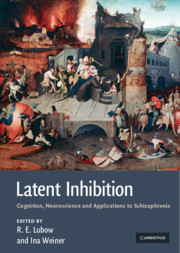Book contents
- Frontmatter
- Contents
- List of contributors
- Preface
- 1 A short history of latent inhibition research
- Current topics in latent inhibition research
- 2 Latent inhibition and extinction: their signature phenomena and the role of prediction error
- 3 Inter-stage context and time as determinants of latent inhibition
- 4 Latent inhibition: acquisition or performance deficit?
- 5 Latent inhibition and learned irrelevance in human contingency learning
- 6 Associative and nonassociative processes in latent inhibition: an elaboration of the Pearce–Hall model
- 7 From latent inhibition to retrospective revaluation: an attentional-associative model
- 8 Latent inhibition and habituation: evaluation of an associative analysis
- 9 Latent inhibition and creativity
- 10 The phylogenetic distribution of latent inhibition
- 11 The genetics of latent inhibition: studies of inbred and mutant mice
- 12 A comparison of mechanisms underlying the CS–US association and the CS–nothing association
- 13 The pharmacology of latent inhibition and its relevance to schizophrenia
- 14 Parahippocampal region–dopaminergic neuron relationships in latent inhibition
- 15 Latent inhibition and other salience modulation effects: same neural substrates?
- 16 What the brain teaches us about latent inhibition (LI): the neural substrates of the expression and prevention of LI
- 17 Latent inhibition in schizophrenia and schizotypy: a review of the empirical literature
- 18 A cautionary note about latent inhibition in schizophrenia: are we ignoring relevant information?
- 19 Latent inhibition as a function of anxiety and stress: implications for schizophrenia
- 20 Nicotinic modulation of attentional deficits in schizophrenia
- 21 Latent inhibition and schizophrenia: the ins and outs of context
- Summary and conclusions
- Index
- References
21 - Latent inhibition and schizophrenia: the ins and outs of context
from Current topics in latent inhibition research
Published online by Cambridge University Press: 04 August 2010
- Frontmatter
- Contents
- List of contributors
- Preface
- 1 A short history of latent inhibition research
- Current topics in latent inhibition research
- 2 Latent inhibition and extinction: their signature phenomena and the role of prediction error
- 3 Inter-stage context and time as determinants of latent inhibition
- 4 Latent inhibition: acquisition or performance deficit?
- 5 Latent inhibition and learned irrelevance in human contingency learning
- 6 Associative and nonassociative processes in latent inhibition: an elaboration of the Pearce–Hall model
- 7 From latent inhibition to retrospective revaluation: an attentional-associative model
- 8 Latent inhibition and habituation: evaluation of an associative analysis
- 9 Latent inhibition and creativity
- 10 The phylogenetic distribution of latent inhibition
- 11 The genetics of latent inhibition: studies of inbred and mutant mice
- 12 A comparison of mechanisms underlying the CS–US association and the CS–nothing association
- 13 The pharmacology of latent inhibition and its relevance to schizophrenia
- 14 Parahippocampal region–dopaminergic neuron relationships in latent inhibition
- 15 Latent inhibition and other salience modulation effects: same neural substrates?
- 16 What the brain teaches us about latent inhibition (LI): the neural substrates of the expression and prevention of LI
- 17 Latent inhibition in schizophrenia and schizotypy: a review of the empirical literature
- 18 A cautionary note about latent inhibition in schizophrenia: are we ignoring relevant information?
- 19 Latent inhibition as a function of anxiety and stress: implications for schizophrenia
- 20 Nicotinic modulation of attentional deficits in schizophrenia
- 21 Latent inhibition and schizophrenia: the ins and outs of context
- Summary and conclusions
- Index
- References
Summary
Introduction
After 50 years of latent inhibition (LI) research, it may come as a surprise that there is, as yet, no generally accepted theoretical account of this apparently simple, robust effect (i.e., a deficit in conditioned responding as a result of prior exposure to the conditioned stimulus). A variety of explanations have been proposed, and many of them, such as conditioned inhibition and habituation, discarded (for a review, see Lubow,1989, pp. 141–189; but see Honey, Iordanova & Good, this volume; Schmajuk, this volume). Currently, one can identify three basic types of LI theories. A-theories, which provided the first accounts of LI (e.g., Lubow, Weiner & Schnur, 1981; Mackintosh, 1975; Pearce & Hall, 1980; Wagner, 1976, 1981; more recently, McLaren & Mackintosh, 2000), accept that passive, inconsequential stimulus preexposures reduce the ability of that stimulus to enter into new associations. In addition, most A-theories explicitly acknowledge the role of attention and attribute the reduction of associability to the decline in stimulus-specific attention or salience.
In contrast to A-theories, R-theories eschew attentional concepts and maintain that stimulus preexposure has no effect on stimulus associability; the stimulus preexposed (PE) and non-preexposed (NPE) groups enter the acquisition stage with the same capability for forming new associations with the unconditioned stimulus. According to R-theories, in the stage-three test, the associations formed during the stage-one preexposure compete for expression with the association formed in the stage-two acquisition (e.g., Bouton, 1993; Miller, Kasprow & Schachtman, 1986; Weiner, 1990).
- Type
- Chapter
- Information
- Latent InhibitionCognition, Neuroscience and Applications to Schizophrenia, pp. 500 - 528Publisher: Cambridge University PressPrint publication year: 2010
References
- 4
- Cited by



